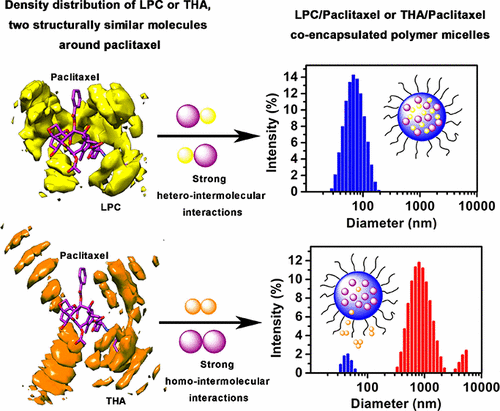当前位置:
X-MOL 学术
›
Mol. Pharmaceutics
›
论文详情
Our official English website, www.x-mol.net, welcomes your
feedback! (Note: you will need to create a separate account there.)
Intermolecular Interactions between Coencapsulated Drugs Inhibit Drug Crystallization and Enhance Colloidal Stability of Polymeric Micelles
Molecular Pharmaceutics ( IF 4.5 ) Pub Date : 2017-09-01 00:00:00 , DOI: 10.1021/acs.molpharmaceut.7b00591 Ling Zhang 1 , Hanzi Sun 2 , Zhen Chen 1 , Zhengsheng Liu 1 , Niu Huang 2 , Feng Qian 1
Molecular Pharmaceutics ( IF 4.5 ) Pub Date : 2017-09-01 00:00:00 , DOI: 10.1021/acs.molpharmaceut.7b00591 Ling Zhang 1 , Hanzi Sun 2 , Zhen Chen 1 , Zhengsheng Liu 1 , Niu Huang 2 , Feng Qian 1
Affiliation

|
Novel “pairs” of drugs possessing pharmacological synergies could be encapsulated into polymeric micelles and exert superb therapeutic effects in vivo upon intravenous administration, with the prerequisite that the micelles remain stable. NADP(H) quinone oxidoreductase 1 (NQO1) inhibitors, such as β-lapachone (LPC) and tanshinone IIA (THA), are structurally and pharmacologically similar molecules that are poorly water-soluble, crystallize extremely fast, and demonstrate synergistic anticancer effect when used together with paclitaxel (PTX). However, when coencapsulated with PTX in poly(ethylene glycol)-b-poly(d,l-lactic acid) (PEG-PLA) micelles, only PTX/LPC but not the PTX/THA pair yields satisfactory colloidal stability. To reveal the molecular mechanism contributing to the colloidal stability of the coencapsulated micelles, we investigated the molecular interactions of PTX/LPC and PTX/THA, through both experimental methods (crystallization kinetics, 13C NMR) and molecular dynamic simulation. We observed that PTX was capable of inhibiting LPC but not THA crystallization both in an aqueous environment and in the solid state, which could be attributed to the strong hetero-intermolecular interactions (π–π, H-bonding) between LPC and PTX, which disrupted the homo-intermolecular interactions between LPC molecules and thus formed a favorable miscible binary system. In comparison, the lack of a strong PTX/THA interaction left the strong THA/THA stacking interaction undisturbed and the fast THA crystallization tendency unrestrained. We conclude that the intermolecular interactions, i.e., the “pharmaceutical synergy”, between the coencapsulated drugs critically control the colloidal stability of polymeric micelles and, therefore, should be evaluated when coencapsulated drug delivery systems are designed for optimal therapeutic benefits.
中文翻译:

包胶药物之间的分子间相互作用抑制药物结晶并增强聚合物胶束的胶体稳定性
具有药理学协同作用的新型“成对”药物可被封装到聚合物胶束中,并在静脉内给药后在体内发挥出色的治疗作用,前提是胶束保持稳定。NADP(H)醌氧化还原酶1(NQO1)抑制剂,例如β-lapachone(LPC)和tanshinone IIA(THA),在结构上和药理学上相似,水溶性差,结晶速度极快,当协同作用时具有抗癌作用与紫杉醇(PTX)一起使用。但是,当与PTX共封装在聚(乙二醇)-b-聚(d,l-乳酸)(PEG-PLA)胶束,只有PTX / LPC而不是PTX / THA对可产生令人满意的胶体稳定性。为了揭示有助于共包封胶束的胶体稳定性的分子机制,我们通过两种实验方法(结晶动力学,13C NMR)和分子动力学模拟。我们观察到,PTX能够抑制LPC,但在水性环境和固态下均不能抑制THA结晶,这可能归因于LPC和PTX之间强烈的异分子间相互作用(π-π,H键)。破坏了LPC分子之间的同分子间相互作用,从而形成了良好的可混溶二元体系。相比之下,缺乏强PTX / THA相互作用使强THA / THA堆叠相互作用不受干扰,而快速THA结晶趋势不受限制。我们得出的结论是,共包封的药物之间的分子间相互作用(即“药物协同作用”)决定性地控制了聚合物胶束的胶体稳定性,因此,
更新日期:2017-09-04
中文翻译:

包胶药物之间的分子间相互作用抑制药物结晶并增强聚合物胶束的胶体稳定性
具有药理学协同作用的新型“成对”药物可被封装到聚合物胶束中,并在静脉内给药后在体内发挥出色的治疗作用,前提是胶束保持稳定。NADP(H)醌氧化还原酶1(NQO1)抑制剂,例如β-lapachone(LPC)和tanshinone IIA(THA),在结构上和药理学上相似,水溶性差,结晶速度极快,当协同作用时具有抗癌作用与紫杉醇(PTX)一起使用。但是,当与PTX共封装在聚(乙二醇)-b-聚(d,l-乳酸)(PEG-PLA)胶束,只有PTX / LPC而不是PTX / THA对可产生令人满意的胶体稳定性。为了揭示有助于共包封胶束的胶体稳定性的分子机制,我们通过两种实验方法(结晶动力学,13C NMR)和分子动力学模拟。我们观察到,PTX能够抑制LPC,但在水性环境和固态下均不能抑制THA结晶,这可能归因于LPC和PTX之间强烈的异分子间相互作用(π-π,H键)。破坏了LPC分子之间的同分子间相互作用,从而形成了良好的可混溶二元体系。相比之下,缺乏强PTX / THA相互作用使强THA / THA堆叠相互作用不受干扰,而快速THA结晶趋势不受限制。我们得出的结论是,共包封的药物之间的分子间相互作用(即“药物协同作用”)决定性地控制了聚合物胶束的胶体稳定性,因此,











































 京公网安备 11010802027423号
京公网安备 11010802027423号